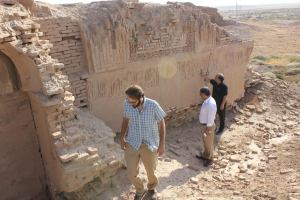Dealing with Issues of Authenticity and Integrity in World Heritage – Along the Silk Route in Iran
Recently I had the opportunity to travel to the Iran, and work with the Iranian Cultural Heritage, Handicrafts, and Tourism Organization (or ICHHTO for short) and as a student of Heritage Management I have to say that as far as life-experiences go, every aspect of the trip was unique, providing with some valuable experience in the issues that arise when dealing with the conservation, protection, and management of world heritage.
The idea behind the trip was that we, my classmate and colleague Hadi Ahmadi of ICHHTO and I, would visit various sites along the Silk Road, travelling westwards from Sarakhs on the eastern border with Turkmenistan, to Qasr-e Shirin on the western border with Iraq, and evaluate their condition, in order to determine whether they would be included in the World Heritage Nomination dossier for the Silk Road Heritage Corridor of Iran. This is an ongoing project by UNESCO with the goal of promoting an international academic dialogue and cultural exchange between the east and the west, by protecting and promoting a very important part of history that is shared by Europe and Asia.

For the first part of this massive project ICHHTO decided that the Caravanserais that are located all over the Silk Road, would best represent Iran’s cultural and economic contribution into the history of this complex road network that spanned 2 continents and 14,000 kilometres. Caravanserais are the “hotels” that were built every 30 or so kilometres to accommodate the traders and travellers that crossed the Silk Road.
Even though the task may seem fairly straight-forward and simple, due to the complex nature of the ownership and history of these sites, it proved to be much harder than we had originally thought. These sites had been continuously used for over 600 years until the invention of the automobile completely changed the nature of the Silk Road, while some of them continued being in use even afterwards for various purposes such as prisons (Caravanserai Robat Sang Bast) or military bases, (Caravanserai Yenge Emam) due to their fortified nature. This meant that very often the authenticity and integrity of the sites would be compromised by architectural interventions from later occupants, or even by irreparable damage caused by natural sources over time. Because of this, we were faced with a dilemma, if we were to assess the historical importance of the sites, with their current condition, we would need to decide at what point the compromised authenticity and integrity of these structures becomes too great for them to accurately represent the cultural, historical, and socio-economic values that they were chosen for.

In reality, this is a very controversial issue, and one that comes down to individual judgement in most cases. Due to each site having a completely different history, different architectural attributes, and representing different cultural and heritage values, there is no singular rule that applies to all of them, and each case needs to be assessed on its own individual merit.

Furthermore, the issue of loss of authenticity and integrity brings up another problem that goes hand-in-hand when trying to define what is considered to be worthy of World Heritage status, at what point in the history of each item of tangible or intangible heritage do we stop considering it to be relevant? This is an issue because a common practice of ICHHTO is to “undo” any changes that were done to a site, in order to restore it to its previous condition. As I previously mentioned, one of the sites we visited was that of the Caravanserai Robat Sang Bast, which after more than 16 years of disuse, was used as a prison for enemy combatants during the war between Iran and Iraq between 1980-1988, and as a prison for the criminally insane up until as recently as 10 years ago. This has completely altered the nature of the site from what its original purpose was as a caravanserai during the years of the Silk Road because of the addition of prison walls and guard towers, turning the guest rooms into cells by adding concrete on the floor and barred doors to prevent escape attempts, as well as barbed wire in many areas to restrict movement of the prisoners. So the issue that we face here is how do we conserve and protect the values this site represents in terms of the Silk Road related heritage, without compromising a different part of its history.
Once again I believe that there really isn’t a “right” answer to this question, and we simply have to approach each case individually and with these issues in mind.
Stefano Vito Mongelli is a post-graduate student of Heritage Management with a background in History and Archaeology.
Hadi Ahmadi currently works for the Iranian Cultural Heritage, Handicrafts, and Tourism Organization, with a BA and MA in Conservation of Architectural Heritage.


Georgia Xekalaki
Dec 08, 2017 at 04:13 pmor…what is really authentic! Good work!